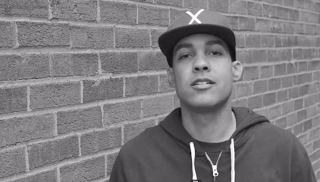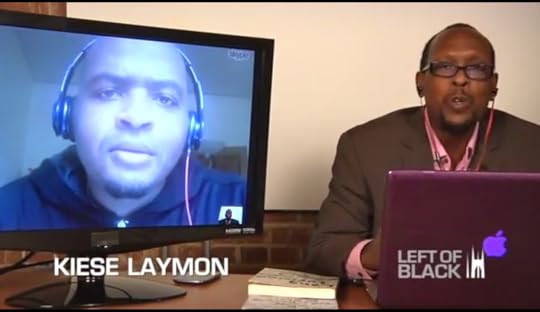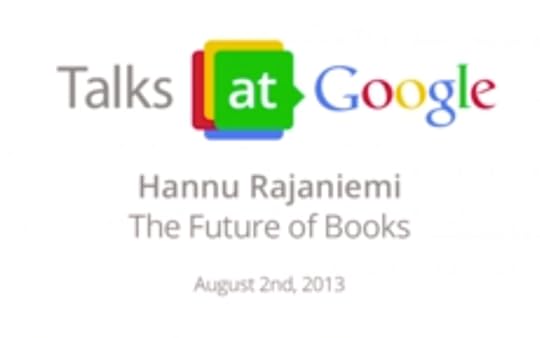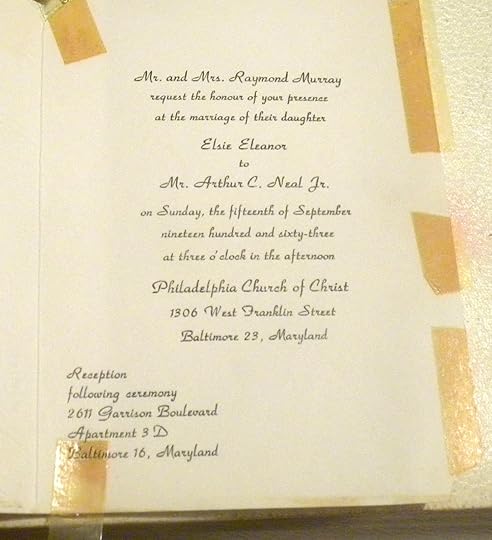Mark Anthony Neal's Blog, page 867
September 18, 2013
"The Fifth Little Girl": Birmingham Church Bombing Survivor Still Seeks Compensation 50 Years On
 Democracy Now
Democracy NowFifty years ago this week, four young girls — Denise McNair, Carole Robertson, Cynthia Wesley and Addie Mae Collins — were killed when the Ku Klux Klan bombed the 16th Street Baptist Church in Birmingham, Alabama. The bombing came less than a month after the landmark March on Washington for Jobs and Freedom. Hundreds gathered in the nation's capital last week to honor their memory when lawmakers posthumously awarded the girls the Congressional Gold Medal. We're joined by Addie Mae's sister, Sarah Collins Rudolph, who is often referred to as the bombing's "fifth victim." Just 12 years old when the church was attacked, Collins Rudolph was hit with shards of glass, lost an eye and was hospitalized for months. Today, she continues to live in Birmingham, suffering from the physical, mental and emotional effects of the bombing. She says she has yet to receive any compensation.
Published on September 18, 2013 06:18
September 17, 2013
"Black Innocence?": a PSA from Jasiri X
 1HoodMedia | Jasiri X
1HoodMedia | Jasiri XI originally wrote this as an introduction to a photojournalism project called "Black Innocence". The editors decided not to use it. After hearing about the death of former FAMU football player Jonathan Ferrell, who was killed by a Charlotte police officer, even though he was unarmed and running to the officers for help, I decided to record it and put it out. Is there such a thing as "Black Innocence" in this society? Take a listen and you be the judge.
Black Innocence?
That's ridiculous
We're labeled as babies that we're cracked, killer kids
No head start we're held back in tenements
At age 6 we're arrested for lack of discipline
At age 9 we're tested but the mission is
To use the test scores to determine our imprisonment
At age 12 is when we learn what suspension is
And school becomes a pipeline to feed us to detention bids
Age 15 disillusioned by what the system is
cause we're subjected to daily Stop and Frisk incidents
At age 17 we get grown man sentences
We're full blown predators shot down by Zimmermans
Black Innocence?
I often wonder if we have that privilege
When another brother's killed over senselessness
And they tell us that we just have to live with it
Black Innocence
Published on September 17, 2013 18:39
White Victimhood and the Media Erasure of Black Death by David J. Leonard
 White Victimhood and the Media Erasure of Black Death
by David J. Leonard | NewBlackMan (in Exile)
White Victimhood and the Media Erasure of Black Death
by David J. Leonard | NewBlackMan (in Exile)Racism is racism. Extreme or mainstream, racism is racism. If it looks like white supremacy, talks like white supremacy and acts like white supremacy, it is white supremacy. What does it mean when the extreme and mainstream trumpet the same tune. What does it mean if white nationalist on Stormfront and Fox and friends similarly lament white victimhood? What does it mean when Skinheads and talk radio similarly rally the white community through fear of black criminals? This convergence and shared ethos has been crystal clear in the aftermath of the Zimmerman trial.
Over the last month, the Right's endless trolling about Chris Lane and Delbert Belton is yet another instance where facts are tossed aside for demonization and criminalization of black bodies. According to Jamelle Bouie, “If Rush Limbaugh, Glenn Beck, and Fox News sell anything, it’s white anger and racial resentment. And for them, Christopher Lane isn’t a person as much as he’s a product.” In fact, their response points to three core principles of the Right: (1) white resentment; (2) a sense of white victimhood; and (3) fear and criminalization of blackness. If a story or a reality doesn’t fulfill those prerequisites, they ain’t got time for it.
Either forgetting or ignoring fact that killing of Trayvon Martin did not make news for weeks, if not months, after his death, erasing the specifics of the case, the narrative about the media not covering “Black-on-White” crime with equal vigor as “White-on-Black Crime” is at its core about an imagined white victimhood.
If the Right and the mainstream media wants to have a conversation about media coverage and the impact of race, that is a conversation to be had, yet it will need to start with the muted media coverage of the killings of Darius Simmons, Bo Morrison, and Jordan Davis; what about the systemic failure to shine a spotlight about #every28hours.
Or how about the almost no coverage of the killing of Kollin Elderts and the trial of Christopher Deedy? It will need to account of the recent shooting of Donald Maisen Jr, who one minute was playing tag and another was lying on the ground in a pool of blood. No coverage from Fox and their Friends across the media; no condemnation from John Boehner, James Woods, or Rush Limbaugh
For such a conversation, it might be useful to look at the spectrum of research regarding not only the overrepresentation of news coverage of cases involving black perpetrators (or those alleged to have committed a crime) or the silence when involving victims of color. It might be helpful to not only look at media silence, but also the crickets from the criminal justice and from the populace as a whole when involving victims of color?
If the Right wants to talk double standards, lets talk about Rekia Boyd and Mark Carson; Anna Brown and Islan Nettles. WDD and the efforts to play up white resentment through a narrative of white victimhood is the true story, not media bias, not political correctness, or not the attack on white America.
If might be useful to talk about the endless pathologizing of blackness and the refusal to interrogate whiteness. Where is the outrage about white-on-white crime? Where are the white leaders demanding answers and discussions of single parents, i-pod lists, parental failures, and poverty? Where is the national discussion on the epidemic of whites killing other whites, whites assaulting other whites, and sexual violence within the white community?
Where are the discussions of mass shootings, white male gun culture, and the pathology of white masculinity? Where are the discussions of white MEN (adults) assaulting, attacking, and shooting Black Children? Age isn’t just a number here. Where is the public debate about state-sanctioned/practice violence and white-on-black gun violence? Where are the calls for examinations of twitter feeds and examinations of potential biases and prejudices?
But those aren’t the race conversations the Right or even mainstream white America wants to have because it would force an interrogation of whiteness and anti-black racism.
Racism is visible each and every day—one has to look no further than the differential responses to the killing of Trayvon Martin, Rekia Boyd, Darius Simmons, Jordan Davis Bo Morrison, Anna Brown, Kollin Elderts, and Islan Nettles and those of Christopher Lane and Delbert Belton. The killing of Martin and so many others has resulted in calls for justice and conversations about race. No demands for stop and frisk white people; no public pronouncements about pathological whiteness; no movements for more police and prisons. And this is what racism looks like.
Sadly before this piece was published another African American was shot dead at the hands of a police officer. Jonathan Ferrell, 24, was seeking help following a car accident. He did what many would think to do or what many white heterosexual men would take for granted – he ran to the closest house to find help. Yet, the appearance of a strange man prompted the resident to call 911. She told the police th“When the police kill an unarmed black or brown male, the media, the political establishment, and even many mainstream civil rights organizations are inclined to give them a major benefit of the doubt,” writes Dave Zirin. “One can ask the families of Ramarley Graham or Sean Bell if that sounds about right. Being stopped by police for DWB (Driving While Black) is outrage enough. Being killed by police for SHWB (Seeking Help While Black) demands a response.”
One cannot understand this case outside of racism, stereotypes and the history of criminalizing black bodies. Research proves that whites, from college students to police officers, are more likely to misidentify a gun when in a black hand. Moreover, according Project Implicit, “An analysis of more than 900,000 completed Implicit Association Tests (IAT) at the Project Implicit website suggested that more than 70% of test takers associated White people with good and Black people with bad more strongly than the reverse.”
It is easy to dismiss race and racism, and make false equivalences, but the daily consequences of American racism are real; the trauma and pain, the ongoing history of racial violence, and a culture that is more likely to see black criminality than black innocence. Racism kills and so does denial.
***
David J. Leonard is Associate Professor in the Department of Critical Culture, Gender and Race Studies at Washington State University, Pullman. Leonard’s latest books include After Artest: Race and the Assault on Blackness (SUNY Press) and African Americans on Television: Race-ing for Ratings (Praeger Press) co-edited with Lisa Guerrero. He is currently working on a book Presumed Innocence: White Mass Shooters in the Era of Trayvon about gun violence in America.
Published on September 17, 2013 06:43
September 16, 2013
Left of Black S4:E1 | "Showing Work" with Writer Kiese Laymon
 Left of Black S4:E1
| "Showing Work" with Writer Kiese Laymon
Left of Black S4:E1
| "Showing Work" with Writer Kiese Laymon
Left of Black host and Duke University Professor Mark Anthony Neal is joined, via Skype, by writer and Vasser College Professor Kiese Laymon.
Kiese Laymon is a black southern writer, born and raised in Jackson, Mississippi. Laymon attended Millsaps College and Jackson State University before graduating from Oberlin College. He earned an MFA from Indiana University and is the author of Long Division and a collection of essays, How to Slowly Kill Yourself and Others in America both published by Agate Bolden. Laymon is a contributing editor at gawker.com. Laymon is currently an Associate Professor of English, Creative Writing and co-director of Africana Studies at Vassar College.Left of Black is a weekly Webcast hosted by Mark Anthony Neal and produced in collaboration with the John Hope Franklin Center at Duke University.
*** Episodes of Left of Blackare also available for free download in @ iTunes U
***
Follow Left of Black on Twitter: @LeftofBlack Follow Mark Anthony Neal on Twitter: @NewBlackMan
Published on September 16, 2013 18:53
"Terrorism is Part of Our History": Angela Davis on Growing up in "Bombingham"
 Democracy Now
Democracy NowSunday marked the 50th anniversary of the bombing of the Sixteenth Street Baptist Church in Birmingham, Alabama, a watershed moment in the civil rights movement. On Sept. 15, 1963, a dynamite blast planted by the Ku Klux Klan killed four young girls in the church -- Denise McNair, age 11, and Carole Robertson, Cynthia Wesley and Addie Mae Collins, all 14 years old. Twenty other people were injured. No one was arrested for the bombings for 14 years. We hear an address by world-renowned author, activist and scholar Angela Davis, professor emerita at University of California, Santa Cruz. She spoke last night in Oakland, California, at an event organized by the Civil Rights and Restorative Justice Project at Northeastern University School of Law.
Published on September 16, 2013 13:47
All-Star Fashion: Russell Westbrook at New York Fashion Week
 The New York Times
The New York TimesThe N.B.A. All-Star and point guard for the Oklahoma City Thunder explores New York's Fashion Week and describes his personal style.
Published on September 16, 2013 04:09
September 15, 2013
For Colored Boys, REDEMPTION | 'Just Let it Go' Ep. 4 of 8 (dir. Stacey Muhammad)
 WildSeed Films
WildSeed FilmsSeason 1, Episode 4 of 8 For Colored Boys, REDEMPTION.
A soul-stirring dramatic series about a father's attempt to repair his broken family after being released from prison, starring Rob Morgan and Julito McCullum with Tim Reid and Jacinto Taras Riddick.
with Lauren Hooper, Nashawn Kearse, Kai Muhammad, Jas Anderson, Ryan Stephenson, and Brittany Chance.
Created, Written and Directed by Stacey Muhammad for Wildseed Films
Executive Produced by Isaiah Washington
Executive Produced by Marc Lamont Hill
Produced by Michael Boogie Pinckney (Black Noise Media)
Produced by Lisa Cynical Smith (Bucktown USA) and The NY Frequency.
Starring: Rob Morgan and Julito McCullum with Tim Reid and Jacinto Taras Riddick
Cast: Lauren Hooper, Nashawn Kearse, Jas Anderson, Lamar K. Cheston, Ephriam Fetti Benton, Brittany Chance, Kai Muhammad, Tekomin Wiliams, Brandhyze Stanley, Ryan Stephenson, Krystal Farris.
Guest appearances by Stephen Hill, Corey Roberts and Prince Po.
Director of Photography: J Anders Urmacher
Edited by: Max Papadop
Casting Director: Tiandra Gayle
Art Direction: Phillip Shung
Music Director: General Steele of Bucktown, USA
Unit Production Manager: Oveta Clinton
Wardrobe Supervisor: Danielle Miller
Hair and Makeup: Jewel Whinfield
www.forcoloredboysseries.com
Published on September 15, 2013 19:48
[Excerpt] 'Demos: An Independent Artist's Guide to Success'
 Life+Times
Life+TimesDirected by Kareem Fort, DEMOS is one of the only documentaries to truly delve into the world of independent hip-hop. Through interviews with Black Thought, Talib Kweli, Naughty By Nature and many more, DEMOS provides artists with an inside look at how to succeed in a music industry that's been radically transformed over the last decade.
Published on September 15, 2013 19:33
Talks @ Google: Hannu Rajaniemi on "The Future of the Book"
 AtGoogleTalks
AtGoogleTalksWhat defines a book? The content, the author, or the experience of reading it? What could books become?
Hannu Rajaniemi, author of science fiction novels The Quantum Thief and The Fractal Prince, argues that the books of the future will read us.
Rajaniemi is the co-creator of Neurofiction, a platform for creating fiction that changes in response to the emotional state of the reader. Neurofiction is powered by open souce software:https://github.com/fommil/neurofiction
Published on September 15, 2013 19:13
September 14, 2013
Of Love and Tragedy in the Shadow of 50 Years of Struggle by Mark Anthony Neal
 Of Love and Tragedy in the Shadow of 50 Years of Struggle
by Mark Anthony Neal | NewblackMan (in Exile)
Of Love and Tragedy in the Shadow of 50 Years of Struggle
by Mark Anthony Neal | NewblackMan (in Exile)On September 14, 1963, a group of men in Birmingham, AL were implementing the final plans for a dynamite attack that would take the lives of four little girls in the 16th Street Baptist Church the next day. Those little girls are the most well known of the six Black children who would lose their lives to racial violence that day.
Hundreds of miles away in Baltimore, MD, Elsie Eleanor Robinson and Arthur C. Neal were putting the final touches on the next day wedding ceremony, that would mark the beginning of 45 years of matrimony (till death did they part), unaware that the date of their planned nuptials would linger forever in the American imagination.
In the years that I shared the earth with my parents, they never once mentioned the drama that played out that day in Birmingham, even in relation to their wedding day. The historical connection only became apparent to me a few months ago, as I sat at a public viewing of Spike Lee’s Four Little Girlswith my ten-year-old daughter Camille, and had one of those a-ha moments.
I’m sure there are thousands of Black partners, who can mark the boundaries of their love and commitment to each other around the violence, trauma and tragedy that our community bore witness to during the Jim Crow era and the valiant struggle for Black Freedom that the era inspired.
Just as I am sure that the pain of those days—which drove my father from the deep south to New York City in the first place—were largely the reason that my parents never felt compelled to talk to me about that day in Birmingham, that day in America, or any of the everydays that undermined this country’s stated belief in liberty and justice for all.
My parents were not movement people. The only hints I ever had of their awareness of the events that shaped the world that they birthed me into were the ever present dime-store portraits of Martin Luther King, Jr. and John Fitzgerald Kennedy, a large blue-and-white button from the Poor People’s Campaign (which they never uttered a word to me about) and the “Jimmy Carter 1980” button they came home with after attending a campaign dinner for the then President. Carter’s 1976 campaigned was the first time my father registered to vote.
Yet both my parents were members of powerful municipal unions in New York City. My mother, the more active of my two parents, never, ever, explained why she dragged me along to labor meetings, though by age 10, I knew who Charlie Hughes—the president of Local 372—was. Hughes led a union largely comprised of Black and Latino women school lunch workers; it was his activism that granted those women to summer salaries and the kinds of benefits that my mother used to earned her college degree, and later Master’s degree—and leave the lunchroom for the classroom, where she became a classroom aide, and later Special Education teacher.
These are the kinds of victories that often get left out of the official details of the Civil Rights era, and perhaps, the reason why folk like my parents, didn’t see any significance in the lives they lived in the shadow of the movement. Indeed the story of the movement is really about the people who took no official stances, did not participate in any marches or join any organizations of note, but who simply continued to live lives of integrity and meaning, despite the tragedies that broke out among them, often on a daily basis.
The ten year-old who watched Four Little Girls with me that recent summer day possesses a natural curiosity and memory, that makes clear that she will be the family historian. Though her grandparents might not have found any added significance to their lives, I’m sure she will never fail to remind her children of the great-grandparents who were married on a day that changed America forever—yet still continued to live lives that make their own lives possible.
Published on September 14, 2013 17:22
Mark Anthony Neal's Blog
- Mark Anthony Neal's profile
- 30 followers
Mark Anthony Neal isn't a Goodreads Author
(yet),
but they
do have a blog,
so here are some recent posts imported from
their feed.



